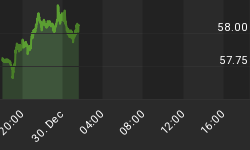Below is an extract from a commentary available to subscribers at www.goldenbar.com on 26th July2005.
The Dow went into the last FOMC weak, and gold strong - after the FOMC they reversed those positions - at the time of writing the Dow fully recovered its losses while gold gave back most of its pre-FOMC gains.
First, the superficial interpretations: the FOMC was good for stocks and bad for gold; or the stock market must be strong because it brushed off the prospect for a continuance of the rate hike campaign; gold is weak and looks like it might topple on the next rate hike. All's good. Dow bulls are happy now that the Fed is wringing the inflation bug out of their bubble bets - since that means, if true, that rates won't have to go up as much in the long run. Greenspan said so himself in his semiannual report to Congress last week - though he also said that certain threats exist to the "flexibility" of the overall market (i.e. to economic freedom), but that for now the economy is "on firm footing," and that in any case the Fed is to be of service to the Royal Crown to save us from any potential bumps. That Bugos must be an idiot. What in Uncle Sam's hell is he talking about? Gold prices are not any more immune to the FOMC's rate hikes than they were in Volcker's reign. But on closer inspection of the facts, taking into account the pre-FOMC moves in these markets, gold was really the one with the net gain, and it has been the one that has rallied into each FOMC, increasingly. I suppose the truth of that will become more apparent in the run up to the next two FOMC's (August 9th and September 20th). I'm betting on it.
Those two months are gold's seasonal best: finishing up almost two thirds of the time since 1972, and delivering between 3 and 5 times the average gain of all other months in that period. Moreover, gold prices had finished up in both August and September in each of the past four years since 2001. During the bull market so far, the average August gain has been 4.5% (or about 20 points from these levels), and the average September gain since 2001 has been about 3.7% (about 15 points), suggesting a total likely gain of about 35 points by the end of September, based solely on the probabilities provided by the historic data. That would bring us back up to the US$455 high if the move was just average, and before taking into account the fact that while the seasonal strong period peaks in September, October tends to be as reliable for bulls as August, and November tends to be as reliable as June, and furthermore, that the seasonal cycle often extends into January. July and December tend to be the countertrend months during a seasonally bullish bias that begins in June and ends in January.
There is one more inference that needs be drawn in relation to seasonality and the state of the current bull leg: the correction off of last November's high (US$455) has not only been one of the mildest (following on a higher high) of any such corrections since this thing started, it has also occurred during a seasonally weak period when the bears should have an edge - especially since, as I have been noting recently, the US dollar has experienced its best foreign exchange move to the upside since its bear market started!
AND WE SHOULDN'T HAVE TO SAY IT ANYMORE… THAT GOLD LEADS THE USd, not vice versa.
Not only has gold become increasingly immune to the FOMC, but also, to threats from the US dollar!!!
















